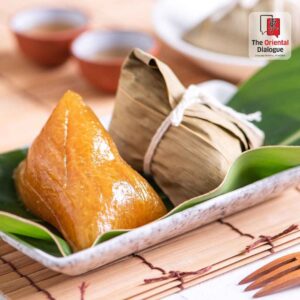Every year, on the 5th day of the 5th month of the Chinese lunar calendar (usually in late May or June), people across China — and many other parts of East Asia — celebrate one of the most iconic and culturally rich festivals of the year: 端午节 (Duānwǔ Jié), also known as the Dragon Boat Festival.
But what’s this festival really about? And why is everyone suddenly obsessed with sticky rice wrapped in leaves?
Let’s dive into the traditions, the tale, and of course, the zòngzi!
🧠 The Story Behind the Festival
The Dragon Boat Festival commemorates Qu Yuan (屈原), a patriotic poet and loyal minister from the State of Chu during the Warring States period. After being exiled due to political intrigue, he drowned himself in the Miluo River as a form of protest when his kingdom was invaded.
Moved by his sacrifice, villagers raced out in boats to search for him — beating drums to scare away evil spirits and throwing sticky rice parcels into the water to prevent fish from eating his body.
💡 Hence: Dragon boat races + zòngzi!
 🚣♂️ The Dragon Boat Races
🚣♂️ The Dragon Boat Races
Across China and in overseas Chinese communities, teams row beautifully decorated dragon-shaped boats to the beat of pounding drums. It’s both a communal celebration and a competitive sport that brings crowds and cultures together.
🍃 The Real Star: 粽子 (Zòngzi) — Sticky Rice Parcels
A beloved tradition of Duānwǔ Jié is eating zòngzi — fragrant, sticky rice dumplings wrapped in bamboo or reed leaves, tied with string, and steamed or boiled.
Zòngzi come in various shapes, fillings, and regional styles. Here are some of the most popular types:
1. 碱水粽 (Jiǎnshuǐ zòng) – Alkaline Water Zòngzi
💛 A golden, chewy zòngzi made with alkaline lye water. It’s often filled with sweet bean paste, red dates, or left plain and eaten with sugar or honey.
2. 北京粽子 (Běijīng zòngzi) – Beijing-Style Zòngzi
🌰 Typically filled with red bean paste, this variety is mild, subtly sweet, and often cone-shaped. It’s popular in the north of China.
3. 广东咸肉粽 (Guǎngdōng xiánròu zòng) – Cantonese Savoury Zòngzi
🥩 Filled with salted egg yolk, pork belly, mung beans, and shiitake mushrooms. This rich, savory style is dense and flavorful — perfect for a meal.
4. 江苏豆沙粽 (Jiāngsū dòushā zòng) – Red Bean Paste Zòngzi from Jiangsu
🍬 A soft and sweet option, usually cylinder-shaped and great for dessert lovers.
5. 台湾客家粽 (Táiwān Kèjiā zòng) – Hakka-Style Taiwanese Zòngzi
🧄 Made with glutinous rice, dried shrimp, peanuts, and pickled radish, this one has bold, earthy flavors and a chewy bite.
 🧧 Fun Fact: The Festival is Also Called “Zòngzi Festival”
🧧 Fun Fact: The Festival is Also Called “Zòngzi Festival”
While it’s officially 端午节, many locals affectionately call it 粽子节 (Zòngzi Jié) — because, let’s be honest, everyone looks forward to the food!
When Is Dragon Boat Festival in 2025?
In 2025, the Dragon Boat Festival (端午节, Duānwǔ Jié) falls on Saturday, May 31. In China, the public holiday spans from May 31 to June 2, offering a three-day celebration filled with cultural activities and traditional foods.
📚 Learn Chinese Through Festivals
Understanding cultural festivals like Duānwǔ Jié adds depth and flavor to your language journey. When you learn Mandarin, you don’t just memorize words — you connect with people, stories, and centuries-old traditions.
🌸 Want to explore Chinese festivals, language & culture in one go?
Join our Mandarin Language Courses at The Oriental Dialogue and discover what makes China’s culture so rich and poetic!
🎓 Registration is open now! 👉 Sign up




